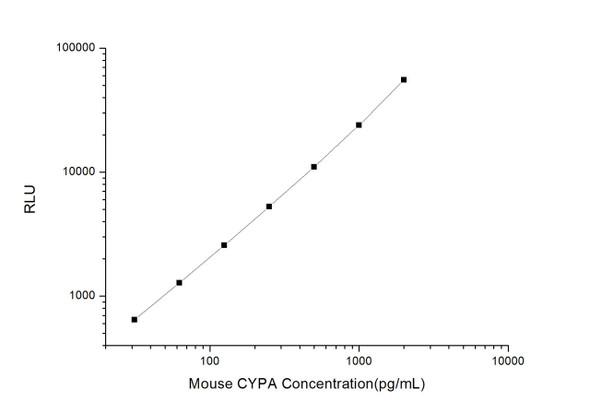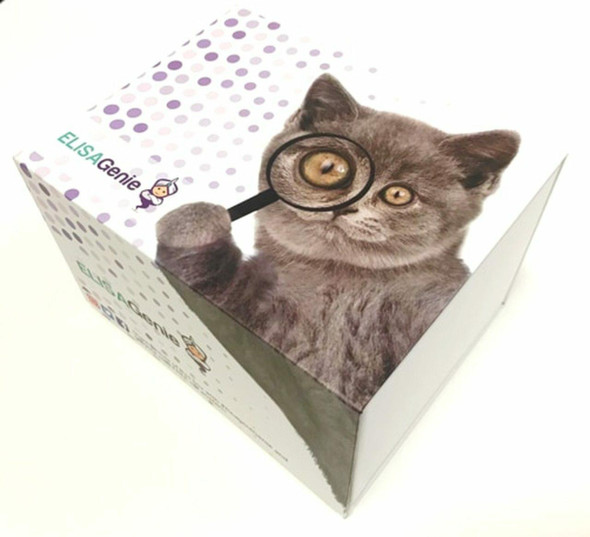Human Immunology ELISA Kits 1
Human CYPA (Cyclophilin A) CLIA Kit (HUES01064)
- SKU:
- HUES01064
- Product Type:
- ELISA Kit
- ELISA Type:
- CLIA Kit
- Size:
- 96 Assays
- Sensitivity:
- 0.19ng/mL
- Range:
- 0.31-20ng/mL
- ELISA Type:
- Sandwich
- Reactivity:
- Human
- Sample Type:
- Serum, plasma and other biological fluids
- Research Area:
- Immunology
Description
| Assay type: | Sandwich |
| Format: | 96T |
| Assay time: | 4.5h |
| Reactivity: | Human |
| Detection method: | Chemiluminescence |
| Detection range: | 0.31-20 ng/mL |
| Sensitivity: | 0.19 ng/mL |
| Sample volume: | 100µL |
| Sample type: | Serum, plasma and other biological fluids |
| Repeatability: | CV < 15% |
| Specificity: | This kit recognizes Human CYPA in samples. No significant cross-reactivity or interference between Human CYPA and analogues was observed. |
This kit uses Sandwich-CLIA as the method. The micro CLIA plate provided in this kit has been pre-coated with an antibody specific to Human CYPA. Standards or samples are added to the appropriate micro CLIA plate wells and combined with the specific antibody. Then a biotinylated detection antibody specific for Human CYPA and Avidin-Horseradish Peroxidase (HRP) conjugate are added to each micro plate well successively and incubated. Free components are washed away. The substrate solution is added to each well. Only those wells that contain Human CYPA, biotinylated detection antibody and Avidin-HRP conjugate will appear fluorescence. The Relative light unit (RLU) value is measured spectrophotometrically by the Chemiluminescence immunoassay analyzer. The RLU value is positively associated with the concentration of Human CYPA. The concentration of Human CYPA in the samples can be calculated by comparing the RLU of the samples to the standard curve.
| UniProt Protein Function: | PPIA: PPIases accelerate the folding of proteins. It catalyzes the cis-trans isomerization of proline imidic peptide bonds in oligopeptides. Interacts with HIV-1 Capsid protein. Binds cyclosporin A (CsA). CsA mediates some of its effects via an inhibitory action on PPIase. Belongs to the cyclophilin-type PPIase family. PPIase A subfamily. |
| UniProt Protein Details: | Protein type:Isomerase; RNA-binding; Cyclophilin; EC 5. 2. 1. 8 Chromosomal Location of Human Ortholog: 7p13 Cellular Component: cytosol; extracellular region; extracellular space; focal adhesion; membrane; nucleus Molecular Function:peptidyl-prolyl cis-trans isomerase activity; protein binding; unfolded protein binding Biological Process: entry into host cell; leukocyte migration; positive regulation of protein secretion; positive regulation of viral genome replication; protein folding; protein peptidyl-prolyl isomerization; regulation of viral genome replication; release of virus from host; RNA-dependent DNA replication; uncoating of virus; viral envelope fusion with host membrane; viral infectious cycle; virus assembly |
| NCBI Summary: | This gene encodes a member of the peptidyl-prolyl cis-trans isomerase (PPIase) family. PPIases catalyze the cis-trans isomerization of proline imidic peptide bonds in oligopeptides and accelerate the folding of proteins. The encoded protein is a cyclosporin binding-protein and may play a role in cyclosporin A-mediated immunosuppression. The protein can also interact with several HIV proteins, including p55 gag, Vpr, and capsid protein, and has been shown to be necessary for the formation of infectious HIV virions. Multiple pseudogenes that map to different chromosomes have been reported. [provided by RefSeq, Jul 2008] |
| UniProt Code: | P62937 |
| NCBI GenInfo Identifier: | 51702775 |
| NCBI Gene ID: | 5478 |
| NCBI Accession: | P62937. 2 |
| UniProt Secondary Accession: | P62937,P05092, Q3KQW3, Q567Q0, Q6IBU5, Q96IX3, Q9BRU4 Q9BTY9, Q9UC61, A8K220, |
| UniProt Related Accession: | P62937 |
| Molecular Weight: | 11,418 Da |
| NCBI Full Name: | Peptidyl-prolyl cis-trans isomerase A |
| NCBI Synonym Full Names: | peptidylprolyl isomerase A |
| NCBI Official Symbol: | PPIA |
| NCBI Official Synonym Symbols: | CYPA; CYPH; HEL-S-69p |
| NCBI Protein Information: | peptidyl-prolyl cis-trans isomerase A |
| UniProt Protein Name: | Peptidyl-prolyl cis-trans isomerase A |
| UniProt Synonym Protein Names: | Cyclophilin A; Cyclosporin A-binding protein; Rotamase A |
| Protein Family: | Peptidyl-prolyl cis-trans isomerase |
| UniProt Gene Name: | PPIA |
| UniProt Entry Name: | PPIA_HUMAN |
As the RLU values of the standard curve may vary according to the conditions of the actual assay performance (e. g. operator, pipetting technique, washing technique or temperature effects), the operator should establish a standard curve for each test. Typical standard curve and data is provided below for reference only.
| Concentration (ng/mL) | RLU | Average | Corrected |
| 20 | 30666 37298 | 33982 | 33950 |
| 10 | 11312 13628 | 12470 | 12438 |
| 5 | 5431 5069 | 5250 | 5218 |
| 2.5 | 2342 2706 | 2524 | 2492 |
| 1.25 | 1487 1279 | 1383 | 1351 |
| 0.63 | 918 816 | 867 | 835 |
| 0.31 | 620 626 | 623 | 591 |
| 0 | 31 33 | 32 | -- |
Precision
Intra-assay Precision (Precision within an assay): 3 samples with low, mid range and high level Human CYPA were tested 20 times on one plate, respectively.
Inter-assay Precision (Precision between assays): 3 samples with low, mid range and high level Human CYPA were tested on 3 different plates, 20 replicates in each plate.
| Intra-assay Precision | Inter-assay Precision | |||||
| Sample | 1 | 2 | 3 | 1 | 2 | 3 |
| n | 20 | 20 | 20 | 20 | 20 | 20 |
| Mean (ng/mL) | 1.06 | 3.18 | 9.95 | 1.00 | 3.11 | 9.14 |
| Standard deviation | 0.11 | 0.25 | 0.99 | 0.11 | 0.36 | 0.98 |
| C V (%) | 10.38 | 7.86 | 9.95 | 11.00 | 11.58 | 10.72 |
Recovery
The recovery of Human CYPA spiked at three different levels in samples throughout the range of the assay was evaluated in various matrices.
| Sample Type | Range (%) | Average Recovery (%) |
| Serum (n=5) | 94-109 | 101 |
| EDTA plasma (n=5) | 94-109 | 100 |
| Cell culture media (n=5) | 89-103 | 95 |
Linearity
Samples were spiked with high concentrations of Human CYPA and diluted with Reference Standard & Sample Diluent to produce samples with values within the range of the assay.
| Serum (n=5) | EDTA plasma (n=5) | Cell culture media (n=5) | ||
| 1:2 | Range (%) | 94-108 | 83-96 | 95-105 |
| Average (%) | 101 | 90 | 100 | |
| 1:4 | Range (%) | 103-115 | 94-107 | 94-109 |
| Average (%) | 109 | 102 | 102 | |
| 1:8 | Range (%) | 99-112 | 95-110 | 97-110 |
| Average (%) | 105 | 101 | 104 | |
| 1:16 | Range (%) | 93-107 | 98-109 | 97-113 |
| Average (%) | 100 | 104 | 105 |
An unopened kit can be stored at 4°C for 1 month. If the kit is not used within 1 month, store the items separately according to the following conditions once the kit is received.
| Item | Specifications | Storage |
| Micro CLIA Plate(Dismountable) | 8 wells ×12 strips | -20°C, 6 months |
| Reference Standard | 2 vials | |
| Concentrated Biotinylated Detection Ab (100×) | 1 vial, 120 µL | |
| Concentrated HRP Conjugate (100×) | 1 vial, 120 µL | -20°C(shading light), 6 months |
| Reference Standard & Sample Diluent | 1 vial, 20 mL | 4°C, 6 months |
| Biotinylated Detection Ab Diluent | 1 vial, 14 mL | |
| HRP Conjugate Diluent | 1 vial, 14 mL | |
| Concentrated Wash Buffer (25×) | 1 vial, 30 mL | |
| Substrate Reagent A | 1 vial, 5 mL | 4°C (shading light) |
| Substrate Reagent B | 1 vial, 5 mL | 4°C (shading light) |
| Plate Sealer | 5 pieces | |
| Product Description | 1 copy | |
| Certificate of Analysis | 1 copy |
- Set standard, test sample and control (zero) wells on the pre-coated plate and record theirpositions. It is recommended to measure each standard and sample in duplicate. Note: addall solutions to the bottom of the plate wells while avoiding contact with the well walls. Ensuresolutions do not foam when adding to the wells.
- Aliquot 100 µL of standard solutions into the standard wells.
- Add 100 µL of Sample / Standard dilution buffer into the control (zero) well.
- Add 100 µL of properly diluted sample (serum, plasma, tissue homogenates and otherbiological fluids. ) into test sample wells.
- Cover the plate with the sealer provided in the kit and incubate for 90 min at 37 °C.
- Aspirate the liquid from each well, do not wash. Immediately add 100 µL of BiotinylatedDetection Ab working solution to each well. Cover the plate with a plate seal and gently mix. Incubate for 1 hour at 37 °C.
- Aspirate or decant the solution from the plate and add 350 µL of wash buffer to each welland incubate for 1-2 minutes at room temperature. Aspirate the solution from each well andclap the plate on absorbent filter paper to dry. Repeat this process 3 times. Note: a microplatewasher can be used in this step and other wash steps.
- Add 100 µL of HRP Conjugate working solution to each well. Cover with a plate seal andincubate for 30 min at 37 °C.
- Aspirate or decant the solution from each well. Repeat the wash process for five times asconducted in step 7.
- Add 100 µL of Substrate mixture solution to each well. Cover with a new plate seal andincubate for no more than 5 min at 37 °C. Protect the plate from light.
- Determine the RLU value of each well immediately.






